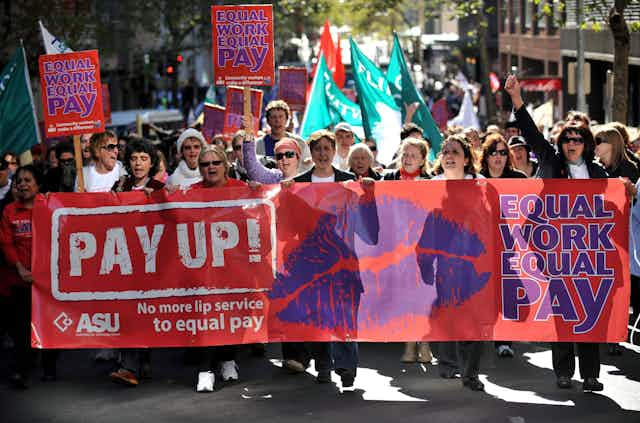Taking action such as correcting like-for-like pay gaps, analysing performance pay and reporting the results to company boards are effective in closing the gender pay gap, new research shows.
We found organisations that completed a pay gap analysis in the 2015-2016 financial year and took action, saw the total salary gender pay gap among top-tier managers reduce on average by 5 percentage points a year later. This compares to a reduction of only 0.22 percentage points for companies that did not take any action at all.
Using data reported to the Workplace Gender Equality Agency each year, we examined the pay of more than four million employees across 11,000 employers. We also assessed what actions companies are taking to address pay equity and what happens down the track as a result.
Read more: For women fighting the gender pay gap discrimination law is limited
The gender pay gaps remain a permanent feature of the Australian labour market, having barely shifted in the last 20 years, despite the advances women have made in both educational attainment, workforce participation and legislation prohibiting discriminatory behaviours.
Gender pay gaps can be a sign of both conscious and unconscious biases, both of which are problematic. They result in poorer outcomes for women in terms of economic and personal freedoms, impair economic growth and represent a lost opportunity in the potential of workers.
Now more Australian employers than ever before are taking pay equity seriously. In the four years of Workplace Gender Equality Agency reporting, employers undertaking a pay gap analysis increased from 24.0% to 37.7%.
The most common action firms take is to do a gender pay gap analysis and report the results to the executive of the company. More than one in four organisations that completed a pay gap analysis in 2016-17 reported their findings to the executive, and 13.9% reported on pay gaps at board level.
More organisations than ever before are implementing specific actions to address like-for-like pay inequities. Like-for-like comparisons are those which look at women and men who are doing work of equal or similar value, but being paid different amounts. A like-for-like gender pay gap is more likely to reflect a level of bias or discrimination when it comes to setting pay.
The actions companies are taking to close like-for-like pay gaps went up from 12.3% to 21% in the two years to 2017, this was among companies which audited pay. This is the most compelling evidence organisations themselves regard pay gaps to be a real issue.
We also find that action on pay equity works better in combination than in isolation. For example, if an organisation commits to correct like-for-like pay gaps it is three times as effective in reducing the overall pay gap, when combined with a commitment to report outcomes to the executive or company board.
This finding is even more apparent at the management level. Gender gaps for managers fell by nearly 13 percentage points between 2015-16 and 2016-17 for companies that combined correcting pay gaps with reporting these results to the board or executive.
When companies reviewed the criteria for performance-related bonuses, and reported those findings to the executive, the gender pay gap in total remuneration for managers fell by 7.3 percentage points (between 2015-16 and 2016-17). This shows the value of examining where discretionary pay can be changed to narrow the gender pay gap.
Addressing the persistent gender pay gap in Australia will ensure that the contributions of all employees are recognised and rewarded, and that Australian businesses capitalise on the full potential of the workforce.
Our new research findings offer some encouragement that Australian businesses are taking the issue of gender pay equity seriously. Now far more businesses are seeking to measure pay differences and review remuneration policies and processes throughout their organisations.
But measurement alone is not enough to break the inertia. Our research shows that Australian companies need to go beyond pay audits to address potential gender bias in remuneration policies. They need to follow through with actions to make a real difference to pay equity outcomes. And leadership accountability is the key ingredient.

